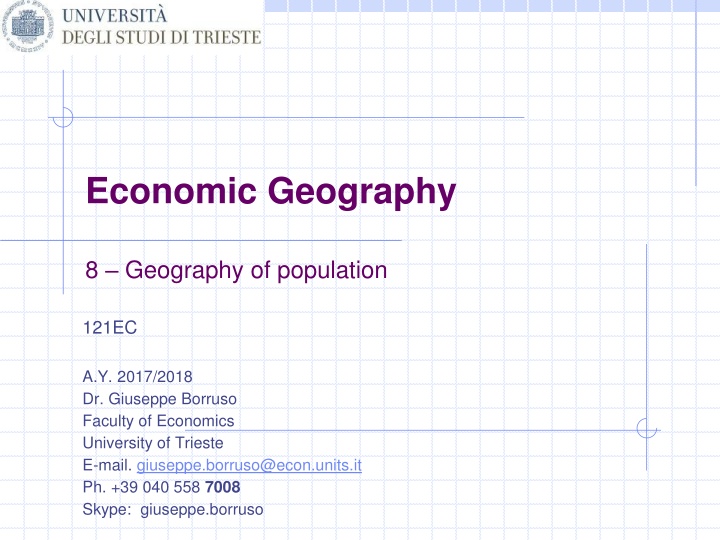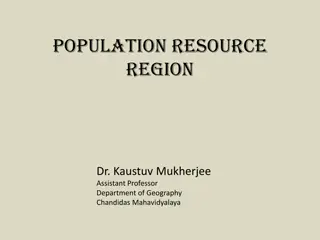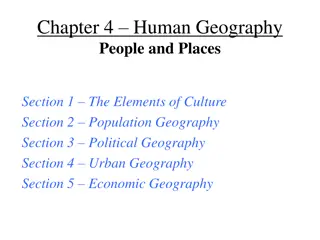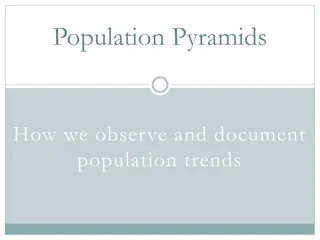
Insight into Global Population Distribution and Trends
Explore the dynamics of population geography and demography, examining global population distribution, fertility, mortality, and historical trends. Understand the challenges and opportunities posed by the world's population explosion, with a focus on human welfare and environmental impact. Visualize data on world population from ancient times to projections for the future.
Download Presentation

Please find below an Image/Link to download the presentation.
The content on the website is provided AS IS for your information and personal use only. It may not be sold, licensed, or shared on other websites without obtaining consent from the author. If you encounter any issues during the download, it is possible that the publisher has removed the file from their server.
You are allowed to download the files provided on this website for personal or commercial use, subject to the condition that they are used lawfully. All files are the property of their respective owners.
The content on the website is provided AS IS for your information and personal use only. It may not be sold, licensed, or shared on other websites without obtaining consent from the author.
E N D
Presentation Transcript
Economic Geography 8 Geography of population 121EC A.Y. 2017/2018 Dr. Giuseppe Borruso Faculty of Economics University of Trieste E-mail. giuseppe.borruso@econ.units.it Ph. +39 040 558 7008 Skype: giuseppe.borruso giuseppe.borruso@econ.units.it
POPULATION DISTRIBUTION AND STRUCTURE 1. Global Population Distribution 2. Fertility and Mortality 3. Population Structure
Demography and Population Geography Demography Systematic analysis of population phenomena through empirical, statistical and mathematical methods. Interested about changes in the population size and composition. Population Geography Concerned by the spatial aspects of population: 1- Simple description of the location of the population. 2- Explanation of its spatial pattern and distribution. 3- Geographical analysis (processes such as urbanization and migration). Demography rather emphasizes on time while population geography emphasizes on space.
The Explosion of the Worlds Population The 20thCentury Huge growth of the world s population. Almost exponential from the 1920s until today. Population was multiplied by three. Around 80-85 million persons are added each year. 60 million new urbanites per year. Urban population is now 2.6 billion, of which 1.7 billions are in developing countries. More than 65% of the global population is thus living in developing economies.
The Explosion of the Worlds Population Human welfare Living conditions are improving in a number of areas, notably in newly industrialized economies. Insufficient to improve the welfare of the bulk of the world s population. Paradox in developing countries: Population growth monitoring is essential in these areas. They have the least resources available to undertake such a process. Challenge of the degradation of the living environment of a significant share of the urban population. As the number of people increases, environmental impact also increases.
World Population, 1000BC- 2050AD (in billions) 10 9 8 7 6 5 4 3 2 1 0 -1000 -750 -500 -250 0 250 500 750 1000 1250 1500 1750 2000
World Population 1804-2054 (in billions) 10 9 2054 26 years 8 2028 15 years 7 2013 14 years 6 1999 12 years 5 1987 13 years 4 1974 14 years 3 1960 33 years 127 years 2 1927 1 1804 0 1800 1850 1900 1950 2000 2050
Possible Trends in Population Growth, 2000-2050 (in billions) 11 10 9 High Medium Low 8 7 6 5 4 2000 2010 2020 2030 2040 2050
The Explosion of the Worlds Population The 1990s Critical decade for the future of the world s population. The world s nations by their actions or inactions will choose their demographic future. Population growth has started to slow down. Difficult to estimate; often lack of reliable population data. 2015 projections (United Nations) Population projections range from a low of 7.10 billion people to 7.83 billion. Difference of 720 million people in the short span of 15 years is nearly equal to the current population of Africa.
The Explosion of the Worlds Population 2050 Projections World population between 7.3 and 10.7 billion. 8.9 billion is the most likely figure. In 1996 this number was estimated to be 9.4 billion. A 500 million difference! Global fertility rates have declined more rapidly than expected. 66% attributed to improvements in health care; smaller families. 33% attributed to increased mortality rates (Sub-Saharan Africa and parts of South Asia).
The Explosion of the Worlds Population Demographic explosion of Third World countries Main ecological catastrophe affecting humanity. Population consumes resources: Food and raw materials. Scarce and often poorly managed. Population consumes energy: Requires important efforts to supply. Several forms of energy supply (coal and petroleum) are highly damaging for the environment. Population consumes space: Often taken at the expense of agriculture or the natural environment.
Context Definition Process during which the population of an area increases. Related to a complex economic, cultural and social environment. Two factors: (1) Number of births exceeds the number of deaths. (2) Migration flow is positive. Expressed in percentages. Birth rate of 20 per 1000 people. Death rate of 10 per 1000 people. Growth rate of 10 people per year per 1000 population, or 1%. Births minus Deaths Positive migratory balance Population Growth Society Economy Culture
Context Reasons for huge population growth Achieved death control more effectively then birth control. Modern medicine: Vastly decreased the number of deaths from many diseases (malaria, yellow fever, etc.). Famine: Reduced through better agriculture, distribution, storage and by international aid mechanisms. Infant mortality: Decreased in most areas. Improvement in the availability and quality of the water supply: Improved hygiene conditions. Decreased deaths caused by water borne diseases.
Context Birth control has been more difficult to achieve Religious beliefs. Cultural traditions. The importance of children as help, labor and security. The role of women is very limited in many societies.
Growth Rates High growth 2% and above. Characteristic of many Third World countries. Average growth Between 1 and 2%. Much of Latin America and parts of Asia, including China. Low growth Between 0 and 1%. Europe, the United States and Canada are currently in this range. Zero population growth (ZPG) Less than 0%. Several European countries. High 2.0% Average 1.0% Low 0.0% ZPG
15 Largest Countries, 2005, 2050 (in millions) -18 Japan 2005 Growth (2005-2050) 34 Viet Nam 44 Philippines 53 Egypt 34 Mexico 96 Congo, DR of 97 Ethiopia 50 Brazil 102 Bangladesh 128 Nigeria 68 Indonesia 188 Pakistan 109 United States 75 China 435 India -200 0 200 400 600 800 1,000 1,200 1,400 1,600
World Population Distribution Evolution of the world s population Long historical process: Has been very slow up to recently. 300 million people around year 0. Remained small until the last 250 years. A new growth trend: Has increased almost exponentially. From 1.6 billion in 1900 to 6 billion in 1999. To what it can be linked? Population explosion Defines a process of strong demographic growth. Started after the Second World War. About 80 million people added each year. Major concern for the future of humanity.
World Population Distribution Global population distribution 3.4 billion people were living Asia in 2002. 21% were Chinese. Overpopulation China adds 1 million people per month. Most of the largest and most crowded cities in the world. Share of Global Population, 2002 8% 21% 5% 11% 7% 17% 12% 19% China India Rest of Asia Europe Middle East
Population Count Future Estimates 2010 http://sedac.ciesin.columbia.edu/data/collection/gpw-v3/maps/gallery/browse
World Population Density and Distribution, 2005 Typical concentrations along major river systems. Areas of large concentrations: South Asia, East Asia, Western Europe, Northeastern North America. Empty areas are attributed to: harsh physical landscapes and harsh temperature.
Fertility and Mortality Total Fertility Rate (TFR) Number of live births per female of reproductive age (15-49). Indicates population change over a long period of time. Instructive about societal norms in any given culture. A TFR of 2.1 is considered as being the replacement birth rate. Lower than 2.1 yields population decrease while rates greater than 2.1 yields population increase. Improvements in medical conditions lower the replacement rate (below 2.06 in many countries). 25 females between 15-49 10 children born that year 1,000 60 TFR = 2.04 = (60/1,000) * (49-15) 22
Total Fertility Rate, Selected Countries, 1995-2010 0 1 2 3 4 5 6 7 8 Yemen 5.2 Niger 7.1 Mexico 2.3 Brazil 1.8 USA 2.1 Russia 1.5 1995 2000 2005 2010 Replacement rate (2.1) Italy 1.4 World 2.5
TFR among Developed Countries, 2005, 2010 South Korea 1.29 1.38 Italy 1.32 Japan 1.36 Germany 1.5 Spain 1.7 Canada 2010 2005 1.9 United Kingdom 1.8 Netherlands 1.9 Sweden 1.93 Australia 1.97 France 2.07 United States 0 0.5 1 1.5 2 2.5
Fertility and Mortality Causes of death Throughout most of history famine, epidemics, and wars have been the leading causes of death. Primary causes of death began to shift to degenerative problems related to aging. These include such factors as heart disease and cancer. Death and welfare Used to be considered a sign of the health of a population. Different age structures among the populations of different countries. Possible for a nation with high living standards to have a higher death rate than a poorer nation. Reason: overall older population.
Crude Death Rate, 2000 Less than 5.00 5.01 - 8.00 8.01 - 10.00 10.01 - 12.00 12.01 - 15.00 More than 15.00 NA
2. Fertility and Mortality Life expectancy Number of years a person is expected to live. Based on current death rates. Does not necessarily apply to current generation. May change due to ameliorations in standards of living. Context Strong geographical variations in life expectancy. Half a century ago, most people died before the age of 50. Global average life expectancy reached 66 years in 2006. Several achievements and failures: Economic development has benefited human health. Improvement in diet and sanitation. Urbanization may have adverse effects.
Life Expectancy Through Human History Era Life expectancy Neanderthal (350,000 25,000 BC) 20 Upper Paleolithic (40,000 10,000 BC) 33 Neolithic (8,500 3,500 BC) 20 Bronze Age (3,500 1,200 BC) 18 Classical Greece and Rome (500 BC 400 AD) Medieval Britain (400 1500 AD) 28 33 Late 19thCentury in Western Europe 37 Average Global Life Expectancy (2006) 66
2. Fertility and Mortality Factors behind higher life expectancy About 40 years was gained in the 20thcentury. 90% of the reduction in the death rate occurred before the introduction of antibiotics or vaccines. Major factors (33 years): Improved sanitation (for food and water). Reduction in crowding. Central heating. Sewer systems. Refrigeration. Improved health (7 years): Mainly medical technology. Small share attributed to drugs.
What Difference a Century Makes: Life Expectancy at Birth, 1910 and 1998 80 73 United States 53 49 81 76 Sweden 59 57 1998 Females 1998 Males 1910 Females 1910 Males 83 77 Japan 43 43 81 75 Italy 47 46 80 75 England 53 49 30 40 50 60 70 80 90
World Average Life Expectancy, 1950-2010 80 75 70 65 60 55 50 45 World Less Developed Regions More Developed Regions 40 35 30 1950-55 1955-60 1960-65 1965-70 1970-75 1975-80 1980-85 1985-90 1990-95 1995-00 2000-05 2005-10
Fertility and Mortality Optimum life expectancy Life expectancy is ultimately dictated by human physiology: At some points, organs cease to function properly. Limit on the lifespan of non-cancerous human cells. Nearing life expectancy limits: Even if age-related diseases such cancer, heart disease, and stroke were eradicated, life expectancy would only increase by 15 years. Currently around 77 years. Expected to reach 85 years in most developed countries by 2030.
Population Pyramid Definition Graph showing the breakdown of each sex by age group (cohort). Age group 75+ Illustrates a nation s population structure. Shows the male/female composition of the population. Most of the time, the breakdown involves 5 years periods. 60-75 Males Females 45-60 30-45 15-30 0-15 10 0 10 Percentage of the population (or total figures)
Population pyramids Developing countries: High natality rate High mortality rate (older classes less populated) > 80 75-79 70-74 65-69 60-64 55-59 50-54 45-49 40-44 35-39 30-34 25-29 20-24 15-19 10-14 5-9 0-4 -500 -400 -300 -200 -100 0 100 200 300 400 500 0-4 5-9 10-14 15-19 20-24 25-29 30-34 35-39 40-44 45-49 50-54 55-59 60-64 65-69 70-74 75-79 > 80 431 422 -431 350 351 -350 275 277 -275 220 221 -220 180 181 -180 150 150 -150 100 102 -100 70 70 -70 45 47 -45 39 40 -39 33 35 -33 25 27 -25 17 17 -17 12 12 -12 8 10 -8 5 7 -5 0 0 0 Female Males Female Female Males
Population pyramids Most Developed countries: Low natality rate (younger classes less populated) Low mortality rate (older classes more populated) Decreasing population in time > 80 75-79 70-74 65-69 60-64 55-59 50-54 45-49 40-44 35-39 30-34 25-29 20-24 15-19 10-14 5-9 0-4 -500 -400 -300 -200 -100 0 100 200 300 400 500 0-4 5-9 10-14 15-19 20-24 25-29 30-34 35-39 40-44 45-49 50-54 55-59 60-64 65-69 70-74 75-79 > 80 300 320 -300 310 310 -310 305 306 -305 320 320 -320 350 350 -350 370 372 -370 375 376 -375 380 382 -380 383 383 -383 380 380 -380 370 370 -370 360 360 -360 330 330 -330 320 322 -320 300 301 -300 250 250 -250 160 161 -160 Femmine Maschi Femmine Femmine Maschi
Population pyramids Case study: Province of Trieste data at 31 Dec 2007 Top values: males and females 35 to 44 and 65 to 69; males 45 to 49, females 60 to 64 and over 80 Decreasing population in time Provincia di Trieste 31/12/2007 > 80 75-79 70-74 65-69 60-64 55-59 50-54 45-49 40-44 35-39 30-34 25-29 20-24 15-19 10-14 5-9 0-4 -20000 -15000 -10000 -5000 0 5000 10000 15000 20000 0-4 5-9 10-14 15-19 20-24 25-29 30-34 35-39 40-44 45-49 50-54 55-59 60-64 65-69 70-74 75-79 > 80 Femmine 4268 Maschi Femmine -4268 -4200 -4223 -4356 -3944 -4301 -6982 -9188 -9779 -8545 -8017 -8695 -8953 -9661 -8378 -7632 -14096 4200 4410 4223 4367 4356 4614 3944 4330 4301 4596 6982 6935 9188 9499 9779 9607 8545 8779 8017 7894 8695 7947 8953 7843 9661 8257 8378 6505 7632 14096 4996 4561 6099 Femmine Maschi
Population Pyramid of Mexico, 2010 100+ 90-94 80-84 70-74 60-64 50-54 Female Male 40-44 30-34 20-24 9-14 0-4 6 4 2 0 2 4 6 Millions
Population Pyramid of Sweden, 2010 100+ 90-94 80-84 70-74 60-64 50-54 Female Male 40-44 30-34 20-24 9-14 0-4 0.5 0.3 0.1 0.1 0.3 0.5 Millions
Population Pyramid of United States, 2010 100+ 90-94 80-84 70-74 60-64 50-54 Female Male 40-44 30-34 20-24 9-14 0-4 12 7 2 3 8 Millions
Ideal situation: Younger classes guarantee population replacement and stability Natality and mortality rate at minimum values Population pyramids > 80 75-79 70-74 65-69 60-64 55-59 50-54 45-49 40-44 35-39 30-34 25-29 20-24 15-19 10-14 5-9 0-4 -500 -400 -300 -200 -100 0 100 200 300 400 500 0-4 5-9 10-14 15-19 20-24 25-29 30-34 35-39 40-44 45-49 50-54 55-59 60-64 65-69 70-74 75-79 > 80 450 440 -450 440 441 -440 430 431 -430 420 421 -420 395 395 -395 375 376 -375 360 361 -360 330 330 -330 300 302 -300 290 290 -290 260 260 -260 240 242 -240 220 220 -220 200 200 -200 170 171 -170 130 132 -130 90 90 -90 Female Males Female Female Males
The world in 2100 The world's population pyramid is changing shape THE world's population will reach 7 billion by the end of October, according to the latest projections from the United Nations. For the first time the UN has attempted to look as far ahead as 2100, using various assumptions about how fertility and mortality rates might change over the years. The average of these estimates suggests that the global population will cross 10 billion by 2085. By 2100, 22.3% of people will be aged 65 or over, up from just 7.6% in 2010. The bulk of population growth is expected to come from the developing world. Africa's population will rise from 1 billion in 2010 to 3.6 billion in 2100. In 1950, 32% of the world's people lived in today's rich countries. By 2100, only 13% will. May 13th 2011, 13:48 by The Economist online http://www.economist.com/blogs/dailychart/2011/05/world_population
Current world population (ranked) http://www.geohive.com/earth/population_now.aspx population (all estimates) yesterday 2012-10- 21 7.075.852.119 rank country area sq.km. 510.072.000 yearly growth daily increase today 2012-10-22 7.076.063.876 World 1,10% 211.757 1. China 9.596.960 1.355.341.010 0,42% 15.539 1.355.356.548 2. India 3.287.590 1.263.451.671 1,32% 45.542 1.263.497.213 3. United States of America 9.826.630 316.616.875 0,85% 7.371 316.624.246 4. 5. 6. 7. 8. Indonesia Brazil Pakistan Nigeria Bangladesh 1.919.440 8.511.965 803.940 923.768 144.000 245.502.908 198.871.616 180.927.944 167.922.975 152.995.226 0,98% 0,84% 1,77% 2,53% 1,25% 6.552 4.56 8.721 11.55 5.236 245.509.459 198.876.176 180.936.666 167.934.525 153.000.462 9. Russian Federation 17.075.200 142.658.517 -0,10% -399 142.658.118 10. Japan 377.835 126.406.332 -0,07% -253 126.406.079 11. 12. 13. 14. Mexico Philippines Viet Nam Ethiopia 1.972.550 300000 329.560 1.127.127 116.551.990 96.968.186 90.010.842 87.088.473 1,14% 1,68% 1,02% 2,07% 3.618 4.435 2.505 4.91 116.555.608 96.972.621 90.013.347 87.093.384 15. Egypt 1.001.450 84.388.089 1,67% 3.837 84.391.925 16. Germany 357.021 81.939.765 -0,20% -456 81.939.309 17. Iran (Islamic Republic of) 1.648.000 75.852.629 1,04% 2.15 75.854.779 18. 19. Turkey Thailand 780.580 514000 74.768.494 69.999.588 1,14% 0,50% 2.319 959 74.770.813 70.000.548 20. Congo, Dem. Rep. of the 2.345.410 70.134.315 2,62% 4.99 70.139.305 21. 22. 23. 24. 25. France United Kingdom Italy South Africa Myanmar 643.427 244.820 301.230 1.219.912 678.500 63.557.279 62.914.294 61.006.609 50.817.813 48.842.799 0,51% 0,60% 0,23% 0,51% 0,79% 888 63.558.167 62.915.332 61.006.989 50.818.523 48.843.857 1.037 379 710 1.057 UN: World Population Prospects: The 2010 Revision.; note: all numbers are estimates, the results of multiplying estimates with estimates should be seen as an indication of what can be, not as what is.
DEMOGRAPHIC THEORY 1. The Malthusian Trap 2. Demographic Transition Theory
Malthusianism 1. Concept What are the principles of Malthusianism? 2. The Malthusian Crisis (trap) What does a Malthusian crisis involves? 3. Contemporary Issues
Concept Context Thomas Malthus (1766-1834) in his book Essays on the Principle of Population (1798). Relationships between population and food resources (area under cultivation). Growth of available resources is linear while population growth is often non- linear (exponential). Took notice of famines in the Middle Ages, especially in the early 14thcentury (1316). From the data he gathered, population was doubling every 25 years. Over a century s time, population would rise by a factor of 16 while food rose by a factor of 4. Deficit Resource growth Demographic growth
1. The Malthusian Trap Demographic growth Creative pressure Opposed to the Malthusian perspective. Often labeled as the economic optimistic view. Brought forward in the early 1960s. Population has a positive impact on economic growth. Resources limited by humanity s potential to invent. Necessity is the mother of all inventions . Scarcity and degradation are the sign of market failures. Population pressure forces the finding of solutions. Problem Higher occupation densities ? Pressures to increase productivity Solution Innovations Outcome Productivity growth
1. The Malthusian Trap Mitigating Resource Depletion Discovery An entirely new class of resources is made available. Often adds to existing resources. Offers new economic opportunities. Substitution An alternative resource is used. Some mineral resources maybe substituted by other, more abundant resources. Composites replacing metals. Fish farming replacing fishing. Telecommunications substituting for travel. Reduce consumption demand through coercion. Recycling The output (waste) becomes an input. Some commodities difficult to recycle. Re-use Some finished goods reused (e.g. clothing, engines, tires). Reducing demand through more efficient use. Reducing
1. The Malthusian Trap Technological innovation and agriculture Intensification of agriculture. New methods of fertilization. Pesticide use. Irrigation. Multi-cropping systems in which more than one crop would be realized per year. Creative pressure and global population growth Would lead to new productivity gains. Humans don t deplete resources but, through technology, create them. Resources will become more abundant. Help overcome shortage in food production and employment.
1. The Malthusian Trap Limits of food production by environmental factors Substitution is not possible for many resources. Soil exhaustion and erosion. Evolutionary factors such as the development of greater resistance to pesticides. Climate change. Loss of productive soils due to land use conversion to other purposes, such as urbanization. Water shortages and pollution. Limits by technology May be available but not shared. Maybe too expensive for some regions (e.g. desalination).
1. The Malthusian Trap Subsistence Economy Subsistence Economy Equilibrium (Births = Deaths) New Technology New Technology Higher incomes, higher births and lower deaths Return to Subsistence Return to Subsistence Populations growth, pressures on resources less births and more deaths Death Rate Births Birth Rate Deaths Subsistence Income Subsistence Income Low Income Subsistence Income Low Income Low Income High Income High Income High Income
The Malthusian Crisis The Malthusian crisis Available agricultural spaces are limited. Technical progresses (machinery, irrigation, fertilizers, and new types of crops) are slow to occur. Increasing incapability to support the population. If this persists, the population will eventually surpass the available resources. The outcomes are Malthusian crises : Food shortages. Famines. War and epidemics. Fix the population in accordance with available resources. Necessity of a moral restraint on reproduction.






















